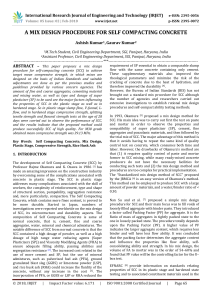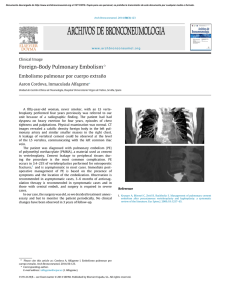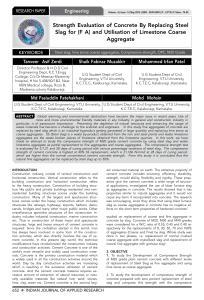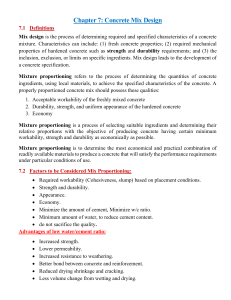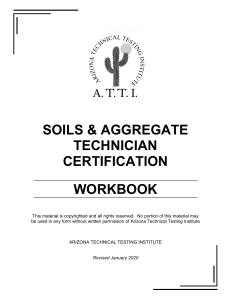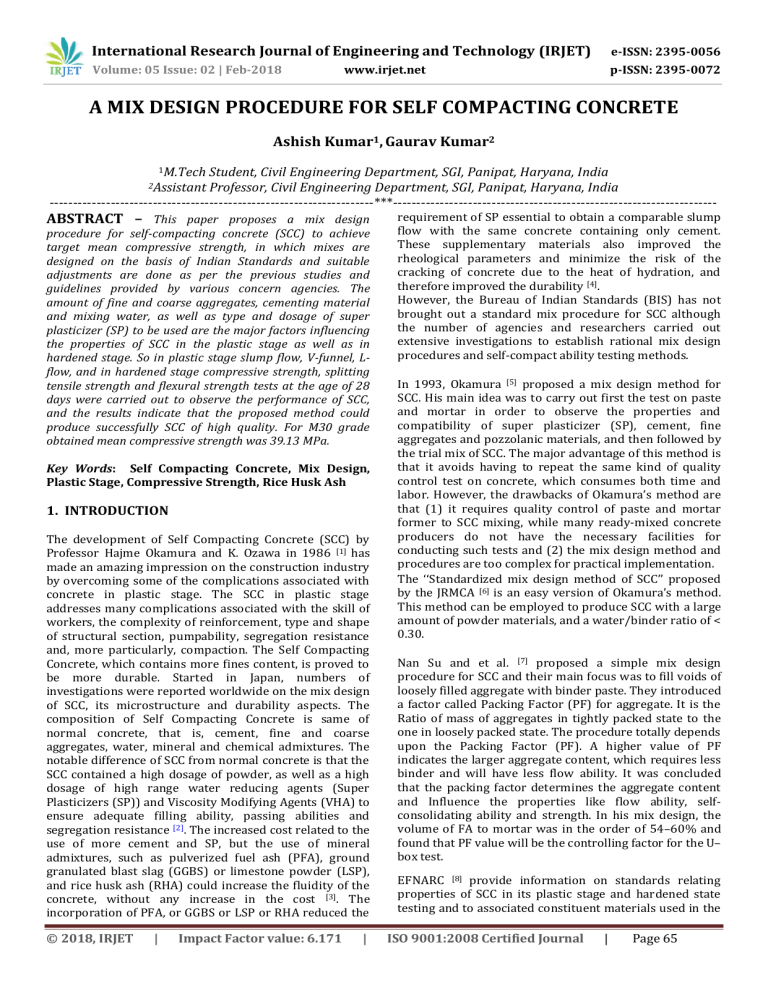
International Research Journal of Engineering and Technology (IRJET) e-ISSN: 2395-0056 Volume: 05 Issue: 02 | Feb-2018 p-ISSN: 2395-0072 www.irjet.net A MIX DESIGN PROCEDURE FOR SELF COMPACTING CONCRETE Ashish Kumar1, Gaurav Kumar2 1M.Tech Student, Civil Engineering Department, SGI, Panipat, Haryana, India Professor, Civil Engineering Department, SGI, Panipat, Haryana, India ---------------------------------------------------------------------***--------------------------------------------------------------------2Assistant ABSTRACT – This paper proposes a mix design procedure for self-compacting concrete (SCC) to achieve target mean compressive strength, in which mixes are designed on the basis of Indian Standards and suitable adjustments are done as per the previous studies and guidelines provided by various concern agencies. The amount of fine and coarse aggregates, cementing material and mixing water, as well as type and dosage of super plasticizer (SP) to be used are the major factors influencing the properties of SCC in the plastic stage as well as in hardened stage. So in plastic stage slump flow, V-funnel, Lflow, and in hardened stage compressive strength, splitting tensile strength and flexural strength tests at the age of 28 days were carried out to observe the performance of SCC, and the results indicate that the proposed method could produce successfully SCC of high quality. For M30 grade obtained mean compressive strength was 39.13 MPa. Key Words: Self Compacting Concrete, Mix Design, Plastic Stage, Compressive Strength, Rice Husk Ash 1. INTRODUCTION The development of Self Compacting Concrete (SCC) by Professor Hajme Okamura and K. Ozawa in 1986 [1] has made an amazing impression on the construction industry by overcoming some of the complications associated with concrete in plastic stage. The SCC in plastic stage addresses many complications associated with the skill of workers, the complexity of reinforcement, type and shape of structural section, pumpability, segregation resistance and, more particularly, compaction. The Self Compacting Concrete, which contains more fines content, is proved to be more durable. Started in Japan, numbers of investigations were reported worldwide on the mix design of SCC, its microstructure and durability aspects. The composition of Self Compacting Concrete is same of normal concrete, that is, cement, fine and coarse aggregates, water, mineral and chemical admixtures. The notable difference of SCC from normal concrete is that the SCC contained a high dosage of powder, as well as a high dosage of high range water reducing agents (Super Plasticizers (SP)) and Viscosity Modifying Agents (VHA) to ensure adequate filling ability, passing abilities and segregation resistance [2]. The increased cost related to the use of more cement and SP, but the use of mineral admixtures, such as pulverized fuel ash (PFA), ground granulated blast slag (GGBS) or limestone powder (LSP), and rice husk ash (RHA) could increase the fluidity of the concrete, without any increase in the cost [3]. The incorporation of PFA, or GGBS or LSP or RHA reduced the © 2018, IRJET | Impact Factor value: 6.171 | requirement of SP essential to obtain a comparable slump flow with the same concrete containing only cement. These supplementary materials also improved the rheological parameters and minimize the risk of the cracking of concrete due to the heat of hydration, and therefore improved the durability [4]. However, the Bureau of Indian Standards (BIS) has not brought out a standard mix procedure for SCC although the number of agencies and researchers carried out extensive investigations to establish rational mix design procedures and self-compact ability testing methods. In 1993, Okamura [5] proposed a mix design method for SCC. His main idea was to carry out first the test on paste and mortar in order to observe the properties and compatibility of super plasticizer (SP), cement, fine aggregates and pozzolanic materials, and then followed by the trial mix of SCC. The major advantage of this method is that it avoids having to repeat the same kind of quality control test on concrete, which consumes both time and labor. However, the drawbacks of Okamura’s method are that (1) it requires quality control of paste and mortar former to SCC mixing, while many ready-mixed concrete producers do not have the necessary facilities for conducting such tests and (2) the mix design method and procedures are too complex for practical implementation. The ‘‘Standardized mix design method of SCC’’ proposed by the JRMCA [6] is an easy version of Okamura’s method. This method can be employed to produce SCC with a large amount of powder materials, and a water/binder ratio of < 0.30. Nan Su and et al. [7] proposed a simple mix design procedure for SCC and their main focus was to fill voids of loosely filled aggregate with binder paste. They introduced a factor called Packing Factor (PF) for aggregate. It is the Ratio of mass of aggregates in tightly packed state to the one in loosely packed state. The procedure totally depends upon the Packing Factor (PF). A higher value of PF indicates the larger aggregate content, which requires less binder and will have less flow ability. It was concluded that the packing factor determines the aggregate content and Influence the properties like flow ability, selfconsolidating ability and strength. In his mix design, the volume of FA to mortar was in the order of 54–60% and found that PF value will be the controlling factor for the U– box test. EFNARC [8] provide information on standards relating properties of SCC in its plastic stage and hardened state testing and to associated constituent materials used in the ISO 9001:2008 Certified Journal | Page 65 International Research Journal of Engineering and Technology (IRJET) e-ISSN: 2395-0056 Volume: 05 Issue: 02 | Feb-2018 p-ISSN: 2395-0072 www.irjet.net production of SCC. The guidelines are drafted with an emphasis on ready-mixed and site mixed concrete where there are requirements between supplier and user in relation to the specification of the concrete in both fresh and Hardened states. In addition, the guidelines cover specific and important requirements for the user of SCC regarding the site preparation and methods of placing where these are different from traditional vibrated concrete. The UPC method is based on simple tests that lead to an SCC mix in four steps [9]. In the first step, the saturation dosage of super plasticizer is determined, using the Marsh cone test, for the paste system having a water/cement ratio of 0.33–0.40; the optimization is started with an assumed value of w/c and this is reduced if the desired strength is not attained. Next, using the mini-slump test, the filler dosage is fixed so that a paste with the saturation super plasticizer dosage has good fluidity and moderate cohesion. In the third step, the aggregate skeleton proportions are fixed by choosing a combination that has the minimum voids in the dry, uncompacted state. With these relative aggregate proportions, concretes with various paste volumes are fabricated and tests in the fourth and final steps, using the paste composition fixed in the second step. The minimum paste volume that yields a self-compactable mix and satisfies the strength requisite is chosen. In spite of an understanding of the concepts and requirements of the mix design methodology, literature available today do not suggest any specific procedure for obtaining SCCs of a definite strength as in normal concretes. 2. MIX DESIGN: 2.1 Design specification 1. 2. 3. 4. 5. 6. Grade of concrete (Used for study) Characteristic Compressive strength Max. size of aggregate (angular) Degree of workability (compaction factor) Degree of quality Type of exposure : M30 : 30 MPa : 12.5 mm : 0.9 : Good : Severe 2.2.1 Cement: Ordinary port land cement of 53 grade of Ultra Tech brand was used in the present study. The physical properties of OPC obtained from the experimental investigation were confirmed to IS12269:1987[10] given below: 1. Sp. gravity of cement (SC) : 3.15 2. Fineness of cement (IS sieve no.9) :7% 3. Normal consistency : 32% 4. Initial setting time : 38 min 5. Soundness (Le Chatelier’s ) : 4 mm 6. Compressive strength of cement | : 38.5 : 54.62 2.2.2 Aggregate: The coarse aggregate used in this study having maximum size of 12.5 mm. The physical properties of coarse aggregate and fine aggregates are tested in accordance with IS: 2386 given below. 1. 2. 3. 4. Water absorption of Coarse aggregate Fine aggregate Free surface moisture of Coarse aggregate Fine aggregate Specific gravity of Coarse aggregate(SCA) Fine aggregate (SFA) Fineness modulus of Coarse aggregate : 0.45% : 1.0% : NIL : NIL : 2.68 : 2.61 : 6.62 : 2.72 Fine aggregate 2.2.3 Admixture: Conplast SP430 complies with IS: 9103 (1979) [11], BS: 5075 (Part 3) and ASTM-C-494 Type ‘F’ as a high range water reducing admixture used as a chemical admixture. Conplast SP430 is based on Sulphonated Naphthalene Polymers and is supplied as brown liquid instantly dispersible in water and specially formulated to give high water reduction up to 25% without loss of workability, Specific gravity 1.22 to 1.225 at 30 °C. In study RHA is used as a mineral admixture as replacement of cement. 2.3.1 Steps in the Mix Proportion [12, 13]: Trail mix 1 2.2 Test data of materials © 2018, IRJET (Requirements of IS269-1989) At 7-days (N/mm2) At 28- days (N/mm2) Impact Factor value: 6.171 | 1. Targeted mean strength for M30 grade concrete fck * = fck + ks fck* = 30 + 1.65 * 5.0 = 38.25N/mm2 Where, Values for k = 1.65 and s = 5.0 (as per table -1 of IS 10262- 2009) 2. Selecting water % for 12.5 mm max size aggregate and the sand lap-up to ZONE -II. 3. For W/C-0.45, C.F-0.9, angular, sand lap-up to ZONE-II. (a) Water content per 1 m3(W) : 197 l/m3 (b) Sand % of total aggregate by : 38% absolute volume (P) 4. Required cement content for given : 437.78kg/m3 W/C ratio (C) 5. Determination of both aggregate contents for the maximum aggregate size of 12.5 mm, the amount of trapped air in the wet concrete is 3%, taking this in to concern and applying equations for the same. V= [W/SW+C/SC+ FA/ (P*SFA)]*1/1000; 0.97 = [197+ (437.78/3.15) +FA/ (0.38*2.61)]*1/1000 FA= 628.82 kg/m3 ISO 9001:2008 Certified Journal | Page 66 International Research Journal of Engineering and Technology (IRJET) e-ISSN: 2395-0056 Volume: 05 Issue: 02 | Feb-2018 p-ISSN: 2395-0072 www.irjet.net V= [W/SW+C/SC+CA/ ((1-P)*SCA)]*1/1000; 0.97 = [197+ (437.78/3.15)+CA/ (0.62*2.68)]*1/1000 CA= 1053.49 kg/m3 The obtained contents of cement, sand, aggregate and water is Cement kg/m3 FA kg/m3 CA kg/m3 Water l/m3 437.78 628.82 1053.49 197 1 1.44 2.41 0.45 fine and coarse aggregate, water, SP are listed below. Cement = 392.73 kg/ m3 RHA = 43.63 kg/ m3 Fine aggregate = 966.94kg/ m3 Coarse aggregate = 729.45kg/ m3 Water = 192 lit/ m3 SP = 9.82 lit/ m3 SP dosage 2.25% of cementation materials = 1200 1000 900 Per cubic meter 800 1000 Per cubic meter 6. Conversion to SCC test specimens: The normal concrete is modified as per EFNARC[8] specifications by considering the fresh properties and hardened properties of the mixes finally conclude to the SCC mix proportion: Water = 197 l/m3 Cement = 437.78 kg/m3 Fine Aggregate (F.A.) = 628.82 kg/m3 Coarse Aggregate (C.A.) = 1053.49 kg/m3 Total Aggregate (T.A) = 1682.31 kg/m3 Let’s Take 56% of Total Aggregate as Fine Aggregate, so Fine Aggregate (F.A.) = 942.09 kg/m3 Coarse Aggregate (C.A.), = 740.22 kg/m3 Further in the trail mix-1 10 % (43.78 kg/ m3) replacement of RHA as cementation material is given. The contents of cement, RHA, fine and coarse aggregate, water, SP are listed below. Cement = 394 kg/ m3 RHA = 43.78 kg/ m3 Fine aggregate = 942.09kg/ m3 Coarse aggregate = 740.22kg/ m3 Water = 197 lit/ m3 SP = 9.84 lit/ m3 SP dosage = 2.25% of cementation materials 800 600 400 200 0 Cement RHA FA CA Water SP Figure 2 Mix Proportion for Trail Mix (TM)-2 2.3.3 Mix proportion [12, 13]: Trail mix 3 For W/C-0.43, C.F-0.9, angular, sand lap-up to ZONE-II Taking 186 lit/m3 water content and 58 % of Total Aggregate as Fine Aggregate. The contents of cement, RHA, fine and coarse aggregate, water, SP are listed below. Cement = 389.31 kg/ m3 RHA = 43.25 kg/ m3 Fine aggregate = 995.21 kg/ m3 Coarse aggregate = 720.68 kg/ m3 Water = 186 lit/ m3 SP = 10.81 lit/ m3 SP dosage = 2.5% of cementation materials 700 600 1200 500 400 1000 300 Per cubic meter 200 100 0 Cement RHA FA CA Water SP Figure 1 Mix Proportion for Trail Mix (TM)-1 2.3.2 Mix proportion [12, 13]: | Trail mix 2 Impact Factor value: 6.171 600 400 200 0 For W/C-0.44, C.F-0.9, angular, sand lap-up to ZONE-II Taking 192 lit/m3 water content and 57% of Total Aggregate as Fine Aggregate. The contents of cement, RHA, © 2018, IRJET 800 | Cement RHA FA CA Water SP Figure 3 Mix Proportion for Trail Mix (TM)-3 ISO 9001:2008 Certified Journal | Page 67 International Research Journal of Engineering and Technology (IRJET) e-ISSN: 2395-0056 Volume: 05 Issue: 02 | Feb-2018 p-ISSN: 2395-0072 www.irjet.net 2.3.3 Mix proportion [12, 13]: Final Mix 1200 1000 1000 Per cubic meter For W/C-0.42, C.F-0.9, angular, sand lap-up to ZONE-II Taking 186 lit/m3 water content and 58 % of Total Aggregate as Fine Aggregate. The contents of cement, RHA, fine and coarse aggregate, water, SP are listed below. Cement = 398.57 kg/ m3 RHA = 44.28 kg/ m3 Fine aggregate = 990.21kg/ m3 Coarse aggregate = 717.04kg/ m3 Water = 186 lit/ m3 SP = 11.07 lit/ m3 SP dosage = 2.5% of cementation materials TM-1 TM-2 TM-3 FM 800 600 400 200 0 Cement 900 Per cubic meter 800 RHA FA CA Water SP Figure 5 Mix Proportion for Trail Mixes and Final Mix 700 Table 2 Properties of Mixes in Plastic Stage 600 500 TEST MIX TM-1 TM-2 TM-3 FM 400 SLUMP TEST SLUMP (mm) 715 705 720 710 T50 Sec 3.34 3.18 3.39 3.23 VFUNNEL T0 Sec 6.22 6.08 6.24 6.12 T5min Sec 8.20 8.14 8.27 7.18 L-BOX T20 Sec 3.15 2.58 3.18 3.12 T40 sec 5.20 5.13 5.25 5.18 H2/H1 0.92 0.89 0.93 0.90 300 200 100 0 Cement RHA FA CA Water SP Figure 4 Mix Proportion for Final mix (FM) 3. RESULT & DISCUSSION: The contents of different ingredients of self compacting concrete for different trial mixes are shown in Figure 5 and ratio of final mix proportion is given in Table 1. Table 1 Ratio of Mix Proportion by Weight As Table 2 shows the test results of concrete in plastic stage the degree of workability of self compacting concrete required depends on w/c ratio, content of cementing material, super plasticizer and content of coarse aggregates and fine aggregates. SSC M30 © 2018, IRJET | 1.62 0.10 Water SP 2.23 RHA 1 CA FA Mix Cement Grade Table 3 Properties of Mixes in Hardened Stage 0.025 0.42 Impact Factor value: 6.171 | TM-1 TM-2 TM-3 FM Compressive Strength, 7 days (MPa) 28.37 28.51 28.84 29.27 Compressive Strength, 28 days (MPa) 37.92 38.37 38.64 39.13 Splitting Tensile 3.15 Strength, 28 days (MPa) 3.32 3.41 3.58 Flexural Strength, 28 days (MPa) 4.52 4.70 4.84 4.26 ISO 9001:2008 Certified Journal | Page 68 International Research Journal of Engineering and Technology (IRJET) e-ISSN: 2395-0056 Volume: 05 Issue: 02 | Feb-2018 p-ISSN: 2395-0072 45 www.irjet.net 7 days 28 days done as per the guidelines provided by different agencies and researcher. Compressive Strength, (Mpa) 40 2. Trail mixes have to be made for maintaining flow ability, self-compatibility and obstruction clearance. 35 30 3. For Final Mix:- Obtained Compressive strength, splitting tensile strength and flexural strength after 28 days for M30 Grade was respectively 39.13 MPa, 3.58 MPa and 4.84 MPa. 25 20 15 REFERENCES 10 [1] K. Ozawa, K. Maekawa, M. Kunishima, H. Okamura, Performance of concrete based on the durability design of concrete structures, Proc. of the Second East Asia-Pacific Conference on Structural Engineering and Construction, 1989. 5 0 TM-1 TM-2 TM-3 FM Figure 6 Compressive Strengths of Mixes As Table 3 and Figure 6 shows mean compressive strengths of mixes required at a specific age, usually 7 days and 28 days, depends on nominal water-cement ratio of the mix and is inversely proportional to the watercement ratio. Obtain the water cement ratio for the desired mean target using the emperical relationship between compressive strength and water cement ratio so chosen is checked against the limiting water cement ratio. The water cement ratio so chosen is checked against the limiting water cement ratio for the requirements of durability given in table and adopts the lower of the two values. Figure 7 showing splitting tensile strength and flexural strength of mixes at 28 days. 6 Splitting Tensile Strength Flexural Strength Strength ( MPa) 5 [2] M. Sonebi, P.J.M. Bartos, W. Zhu, J. Gibbs, A. Tamimi, Final Report Task 4, Hardened properties of SCC, Brite-EuRam Contract No. BRPRTC96-0366, Hardened Properties of SCC, Brussels, (2000) 75 p. [3] M. Sonebi, P.J.M. Bartos, Filling ability and plastic settlement of self compacting concrete, Mat. Struct. 35 (252) (Sept– Oct, 2002) 462–469. [4] A. Yahia, M. Tanimura, A. Shimabukuro, Y. Shimoyama, T. Tochigi, Effect of mineral admixtures on rheological properties of equivalent selfcompacting concrete mortar, in: H. Okamura, H. Shima (Eds.), Seventh East Asia-Pacific Conference on Structural Engineering and Construction, vol. 21 (2), Kochi University of Technology, Japan, 1999, pp. 559– 564. [5] H. Okamura, K. Maekawa, K. Ozawa, High Performance Concrete, Gihoudou Pub., Tokyo, 1993 (in Japanese). 4 [6] Japanese Ready-Mixed Concrete Association, Manual of Producing High Fluidity (Self-Compacting) Concrete, Japanese Ready-Mixed Concrete Association, Tokyo, 1998 (in Japanese). 3 2 [7] Nan Su, Kung-Chung Hsu, His-Wen Chai “A Simple Mix Design Method for Self-Compacting Concrete” Journal of Cement and Concrete Research 31 (2001) pp 1799-1807. 1 0 TM-1 TM-2 TM-3 FM Figure 7 Splitting Tensile Strength and Flexural Strength of Mixes 3. CONCLUSIONS 1. As no definite mix design method for SCC are available, mix design can be done with conventional Bureau of Indian Standard method and suitable adjustments can be © 2018, IRJET | Impact Factor value: 6.171 | [8] The European Guidelines for Self–Compacting Concrete” (Specification, Production and Use) May 2005. [9] Gomes PCC, Gettu R, Agulló L, Bernad C. Experimental optimization of high strength self-compacting concrete. In: Ozawa K, Ouchi M, editos. Proc second int symp self-compacting concr. Kochi, Japan, COMS Eng Corp. 2001; p. 377–86. ISO 9001:2008 Certified Journal | Page 69 International Research Journal of Engineering and Technology (IRJET) e-ISSN: 2395-0056 Volume: 05 Issue: 02 | Feb-2018 p-ISSN: 2395-0072 www.irjet.net [10] IS: 12269 (53 Grade Ordinary Portland cement Specifications), Indian Standard Code, 1987. [11] IS 9103:1999 Admixtures. – Indian Standard Concrete [12] Bureau of Indian Standards. “Plain and reinforced concrete code for practice”, IS-456 (2000), New Delhi. [13] IS: 10262 (Concrete Mix Proportioning- Guidelines), Indian Standard Code, 2009. © 2018, IRJET | Impact Factor value: 6.171 | ISO 9001:2008 Certified Journal | Page 70

